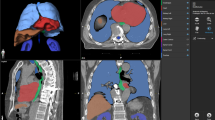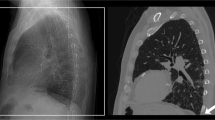Abstract
Objectives
Segmentation and landmarking of computed tomographic (CT) images of pediatric patients are important and useful in computer-aided diagnosis, treatment planning, and objective analysis of normal as well as pathological regions. Identification and segmentation of organs and tissues in the presence of tumors is difficult. Automatic segmentation of the primary tumor mass in neuroblastoma could facilitate reproducible and objective analysis of the tumor’s tissue composition, shape, and volume. However, due to the heterogeneous tissue composition of the neuroblastic tumor, ranging from low-attenuation necrosis to high-attenuation calcification, segmentation of the tumor mass is a challenging problem. In this context, we explore methods for identification and segmentation of several abdominal and thoracic landmarks to assist in the segmentation of neuroblastic tumors in pediatric CT images.
Materials and methods
Methods are proposed to identify and segment automatically peripheral artifacts and tissues, the rib structure, the vertebral column, the spinal canal, the diaphragm, and the pelvic surface. The results of segmentation of the vertebral column, the spinal canal, the diaphragm and the pelvic girdle are quantitatively evaluated by comparing with the results of independent manual segmentation performed by a radiologist.
Results and conclusion
The use of the landmarks and removal of several tissues and organs assisted in limiting the scope of the tumor segmentation process to the abdomen, and resulted in the reduction of the false-positive error rates by 22.4%, on the average, over ten CT exams of four patients, and improved the result of segmentation of neuroblastic tumors.
Similar content being viewed by others
References
Doi K (2007) Computer-aided diagnosis in medical imaging: Historical review, current status and future potential. Comput Med Imaging Graph 31(4–5): 198–211
Karssemeijer N, Erning LJTO, Eijkman EGJ (1988) Recognition of organs in CT image sequences: a model guided approach. Comput Biomed Res 21(5): 434–448
Park H, Bland PH, Meyer CR (2003) Construction of an abdominal probabilistic atlas and its application in segmentation. IEEE Trans Med Imaging 22(4): 483–492
Kobatake H (2006) Future CAD in multi-dimensional medical images—project on multi-organ, multi-disease CAD system. Comput Med Imaging Graph 31(4-5): 258–266
Hugueny S, Rousson M (2007) Hierarchical detection of multiple organs using boosted features. In: Kropatsch WG, Kampel M, Hanbury A (eds) Computer analysis of images and patterns, Lecture Notes in Computer Science, vol 4673. Springer, Berlin, pp 317–325
Shimizu A, Sakurai H, Kobatake H, Nawano S, Smutek D (2007) Improvement of a multi-organ extraction algorithm in an abdominal CAD system based on features in neighbouring regions. In: Proceedings of CARS 21st international congress and exhibition: computer assisted radiology and surgery, vol 2(1). Berlin, Germany, pp 386–388
Lee CC, Chung PC, Tsai HM (2003) Identifying multiple abdominal organs from CT image series using a multimodule contextual neural network and spatial fuzzy rules. IEEE Trans Inf Technol Biomed 7(3): 208–217
Fujimoto H, Gu L, Kaneko T (2002) Recognition of abdominal organs using 3D mathematical morphology. Syst Comput Jpn 33(8): 75–83
Kobashi M, Shapiro LG (1995) Knowledge-based organ identification from CT images. Pattern Recognit 28(4): 475–491
Hill A, Taylor CJ, Brett AD (2000) A framework for automatic landmark identification using a new method of nonrigid correspondence. IEEE Trans Pattern Anal Mach Intell 22(3): 241–251
Dhawan AP (2003) Medical image analysis. IEEE Press, Piscataway
Brown MS, McNitt-Gray MF (2000) Medical image interpretation. In: Sonka M, Fitzpatrick JM (eds) Handbook of medical imaging. Medical Image Processing and Analysis, vol 2. SPIE Press, Bellingham, pp 399–445
Archip N, Erard PJ, Petersen ME, Haefliger JM, Germond JF (2002) A knowledge-based approach to automatic detection of the spinal cord in CT images. IEEE Trans Med Imaging 21(12): 1504–1516
Qatarneh SM, Noz ME, Hyödynmaa S, Maguire GQ, Kramer EL, Crafoord J (2003) Evaluation of a segmentation procedure to delineate organs for use in construction of a radiation therapy planning atlas. Int J Med Inform 69(1): 39–55
Rohlfing T, Russakoff DB, Maurer CR (2004) Performance-based classifier combination in atlas-based image segmentation using expectation-maximization parameter estimation. IEEE Trans Med Imaging 23(8): 983–994
Ehrhardt J, Handels H, Plötz W, Pöppl SJ (2004) Atlas-based recognition of the anatomical structures and landmarks and the automatic computation of the orthopedic parameters. Methods Inf Med 43(4): 391–397
Zhou X, Kamiya N, Hara T, Fujita H, Chen H, Yokoyama R, Hoshi H (2007) Automated segmentation and recognition of abdominal wall muscles in X-ray torso CT images and its application in abdominal CAD. In: Proceedings of CARS 21st international congress and exhibition: computer assisted radiology and surgery, vol 2, pp 388–390
Furst JD, Susomboom R, Raicu DS (2006) Single organ segmentation filters for multiple organ segmentation. In: Proceedings of the 28th annual international conference of the IEEE Engineering in Medicine and Biology Society, Lyon, France, pp 3033–3036
Camara O, Colliot O, Bloch I (2004) Computational modeling of thoracic and abdominal anatomy using spatial relationships for image segmentation. Real-Time Imaging 10(4): 263–273
Yao J, O’Connor SD, Summers RM (2006) Automated spinal column extraction and partitioning. In: Proceedings of the third IEEE international symposium on biomedical imaging: Nano to Macro, Arlington, pp 390–393
Wang H, Bai J, Zhang Y (2005) A relative thoracic cage coordinate system for localizing the thoracic organs in chest CT volume data. In: Proceedings of the 27th annual international conference of the IEEE Engineering in Medicine and Biology Society, Shanghai, China, pp 3257–3260
Staal J, Ginneken BV, Viergever MA (2004) Automatic rib segmentation in CT data. In: Sonka M, Kakadiaris IA, Kybic J (eds) Computer vision and mathematical methods in medical and biomedical image analysis, vol 3117/2004. Springer, Berlin, pp 193–204
Karangelis G, Zimeras S (2002) 3D segmentation method of the spinal cord applied on CT data. Comput Graph Top 14(1/2002): 28–29
Rangayyan RM, Deglint HJ, Boag GS (2006) Method for the automatic detection and segmentation of the spinal canal in computed tomographic images. J Electron Imaging 15(3): 033007–1:9
Hahn M, Beth T (2004) Balloon based vertebra separation in CT images. In: Proceedings of the 17th IEEE symposium on computer-based medical systems, Los Alamitos, pp 310–315
Rangayyan RM, Vu RH, Boag GS (2008) Automatic delineation of the diaphragm in computed tomographic images. J Digit Imaging 21(1): S134–S147
Kushner BH (2004) Neuroblastoma: a disease requiring a multitude of imaging studies. J Nucl Med 45(7): 101–105
Brodeur GM, Maris JM (2002) Neuroblastoma. In: Pizzo PA, Poplack DG (eds) Principles and practice of pediatric oncology. Lippincott Williams & Wilkins, Philadelphia, pp 895–937
Caron HN, Pearson ADJ (2005) Neuroblastoma. In: Voûte PA, Barrett A, Stevens MCG, Caron HN (eds) Cancer in children: clinical management. Oxford University Press, Oxford, pp 337–352
Brodeur GM, Pritchard J, Berthold F, Carlsen NLT, Castel V, Castleberry RP, DeBernardi B, Evans AE, Favrot M, Hedborg F, Kaneko M, Kemshead J, Lampert F, Lee REJ, Look AT, Pearson ADJ, Philip T, Roald B, Sawada T, Seeger RC, Tsuchida Y, Voûte PA (1993) Revisions of the international criteria for neuroblastoma diagnosis, staging, and response to treatment. J Clin Oncol 11(8): 1466–1477
Deglint HJ, Rangayyan RM, Ayres FJ, Boag GS, Zuffo MK (2007) Three-dimensional segmentation of the tumor in computed tomographic images of neuroblastoma. J Digit Imaging 20(1): 72–87
Vu RH, Rangayyan RM, Deglint HJ, Boag GS (2007) Segmentation and analysis of neuroblastoma. J Franklin Inst 344(3–4): 257–284
Ayres FJ, Zuffo MK, Rangayyan RM, Boag GS, Filho VO, Valente M (2004) Estimation of the tissue composition of the tumor mass in neuroblastoma using segmented CT images. Med Biol Eng Comput 42: 366–377
Rangayyan RM, Vu RH, Boag GS (2006) Delineation of the diaphragm in CT images to improve segmentation of the tumor mass in neuroblastoma. In: Proceedings of CARS 20th international congress and exhibition: computer assisted radiology, Osaka, Japan, pp 78–80
Banik S, Rangayyan RM, Boag GS (2008) Delineation of the pelvic girdle in computed tomographic images. In: Proceedings of the 21st IEEE Canadian conference on electrical and computer engineering, Niagara Falls, pp 179–182
Banik S, Rangayyan RM, Boag GS (2008) Landmarking of computed tomographic images to assist in segmentation of abdominal tumors caused by neuroblastoma. In: Proceedings of the 30th annual international conference of the IEEE Engineering in Medicine and Biology Society, Vancouver, pp 3126–3129
Kim DY, Park JW (2004) Computer-aided detection of kidney tumor on abdominal computed tomography scans. Acta Radiol 45(7): 791–795
Linguraru MG, Yao J, Gautam R, Peterson J, Li Z, Linehan WM, Summers RM (2009) Renal tumor quantification and classification in contrast-enhanced abdominal CT. Pattern Recognit (in press)
Kaus MR, Warfield SK, Nabavi A, Black PM, Jolesz FA, Kikinis R (2001) Automated segmentation of MR images of brain tumors. Radiology 218(2): 586–591
Soler L, Delingette H, Malandain G, Montagnat J, Ayache N, Koehl C, Dourthe O, Malassagne B, Smith M, Mutter D, Marescaux J (2001) Fully automatic anatomical, pathological, and functional segmentation from CT scans for hepatic surgery. Comput Aided Surg 6(3): 131–142
Dougherty ER (1992) An introduction to morphological image processing. SPIE Press, Bellingham
Vincent L (1993) Morphological grayscale reconstruction in image analysis: applications and efficient algorithms. IEEE Trans Image Process 2(2): 176–201
Dawant BM, Zijdenbos AP (2000) Image segmentation. In: Sonka M, Fitzpatrick JM (eds) Handbook of medical imaging: medical image processing and analysis, vol 2. SPIE Press, Bellingham, pp 71–127
Bloch I (1993) Fuzzy connectivity and mathematical morphology. Pattern Recognit Lett 14: 483–488
Bezdek JC (1992) Fuzzy models for pattern recognition: methods that search for structures in data. IEEE Press, New York
Udupa JK, Samarasekera S (1996) Fuzzy connectedness and object definition: theory, algorithms, and applications in image segmentation. Graph Models Image Process 58(3): 246–261
Rosenfeld A (1984) The fuzzy geometry of image subsets. Pattern Recognit Lett 2(5): 311–317
Kass M, Witkin A, Terzopoulos D (1988) Snakes: active contour models. Int J Comput Vis 1(4): 321–331
Xu C, Pham DL, Prince JL (2000) Image segmentation using deformable models. In: Sonka M, Fitzpatrick JM (eds) Handbook of medical imaging: medical image processing and analysis, vol 2. SPIE Press, Bellingham, pp 129–174
Xu C, Prince JL (1998) Snakes, shapes, and gradient vector flow. IEEE Trans Image Process 7(3): 359–369
Hough PVC (1962) A method and means for recognizing complex patterns. US Patent 3,069,654, 18 December 1962
Duda RO, Hart PE (1972) Use of the Hough transform to detect lines and curves in pictures. Commun ACM 15(1): 11–15
Huttenlocher DP, Klanderman GA, Rucklidge WJ (1993) Comparing images using the Hausdorff distance. IEEE Trans Pattern Anal Mach Intell 15(9): 850–853
Xu J, Chutatape O, Chew P (2007) Automated optic disk boundary detection by modified active contour model. IEEE Trans Biomed Eng 54(3): 473–482
Mäkelä T, Clarysse P, Sipilä O, Pauna N, Pham QC, Katila T, Magnin IE (2002) A review of cardiac image registration methods. IEEE Trans Med Imaging 21(9): 1011–1021
Mategrano VC, Petasnick J, Clark J, Bin AC, Weinstein R (1977) Attenuation values in computed tomography of the abdomen. Radiology 125: 135–140
Phelps ME, Hoffman EJ, Ter-Pogossian MM (1975) Attenuation coefficients of various body tissues, fluids and lesions at photon energies of 18 to 136 keV. Radiology 117: 573–583
Rangayyan RM, Banik S, Boag GS (2008) Automatic segmentation of the ribs and the vertebral column in computed tomographic images of pediatric patients. In: Proceedings of CARS 22nd international congress and exhibition: computer assisted radiology and surgery, vol 3(1), Barcelona, pp S42–S44
Banik S, Rangayyan RM, Boag GS (2009) Automatic segmentation of the ribs, the vertebral column, and the spinal canal in pediatric computed tomographic images. J Digit Imaging (in press)
Hu S, Hoffman EA, Reinhardt JM (2001) Automatic lung segmentation for accurate quantitation of volumetric X-ray CT images. IEEE Trans Med Imaging 20(6): 490–498
Chaffee EE, Greisheimer EM (1974) Basic physiology and anatomy, 3rd edn. J. B. Lippincott, New York
Author information
Authors and Affiliations
Corresponding author
Rights and permissions
About this article
Cite this article
Rangayyan, R.M., Banik, S. & Boag, G.S. Landmarking and segmentation of computed tomographic images of pediatric patients with neuroblastoma. Int J CARS 4, 245–262 (2009). https://doi.org/10.1007/s11548-009-0289-y
Received:
Accepted:
Published:
Issue Date:
DOI: https://doi.org/10.1007/s11548-009-0289-y




